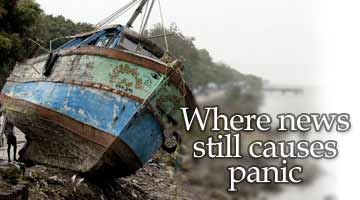
It might be snowing in up north in Kashmir, but Kanyakumari, the southernmost district of mainland India, is sweltering. It is so hot that even the young girl selling seashells by the seashore is taking shelter under the miniscule shade a parked cycle cart provides.
The sea is choppy, but the ferry service to Vivekananda Rock has resumed. Two out of the three boats that ply here are in service. The one damaged by the tsunami is still under repair.
The crowds are sparse. Assistant conservator of the port G Ramalingam says February is usually a lean month but this year it has been leaner than usual. On an average February day, there used to be 2,000 to 3,000 passengers; now that figure is hardly 1,000.
Ramalingam vividly remembers tsunami Sunday. "We had sold 3,469 tickets from 8 am to 9:45 am. The sea was rough, so we stopped the service to Valluvar Rock (adjacent to Vivekananda Rock) at 9 am," he says. "The decision probably saved the lives of at least 500 people who would have been on Valluvar Rock at that time."
Also Read: Still scared of the sea
"The 1,300 people stranded on Vivekananda Rock were safe as the hall inside can accommodate 2,000 people. On the Valluvar Rock there is no shelter at all," Ramalingam adds.
The fishermen have not gone back to the sea yet. They feel if they go back to work they will not get the promised compensation from the government.
Also Read: The lost fishermen of Talaguda
The adolescent girls home for tsunami children in Thuckalay is very quiet. The 15 occupants are playing on the verandah. One of them, Chandra, wants to be a nurse. Another, Jesurani, wants to study computers. Mabel Rani, a destitute woman with two children, is a trained teacher. She is trying for a teacher's job. The others don't know what to do. They look sad and listless. They have nowehere to go, nothing to look forward to, no ambitions, no dreams.
Vijaya, the superintendent, says the government has not given any instruction on what to do with the girls. "We will start teaching them tailoring here," she says. She is teaching them yoga now.
Also Read: Return to life
At the parish church in Colachel, there is a big room where girls learn tailoring. It is now a medical camp run by the SMCSI medical college. Tsunami-affected people come here for free treatment. For many people, says Dr Blessed Singh, wounds inflicted while running away from the deadly waves have not healed. The people don't dress the wounds properly or take medicines on time, he adds.
Every time a non-governmental organisation comes with relief material they run, crowd and around and fight with each other. This aggravates the wounds, discloses Dr Singh.
Also Read: Priyanka finds a home
Those who were tossed about by the waves have respiratory problems because of the salty seawater that got into their lungs. They are being given antibiotics. The serious cases are being X-rayed.
A few days ago, the morning daily in coastal Kottilpadu near Colachel reported an earthquake in the Pacific and wondered if it would affect India. The people here did not wonder. They panicked.
The parents rushed to the local school and wanted their children back. Villagers in the government temporary shelters started running with their meagre belongings. The panic subsided only when Kanyakumari District Collector Sunil Paliwal came and assured the people nothing was wrong. He told them the government would warn them if anything was amiss.
Also Read: Found by govt, lost by NGOs
In Nagercoil, the orphanage for tsunami children is noisy as usual. There are kids as small as four years old here. Two boys run and open the gate for our car before the watchman, old and grumbling, can. The children are too naughty to be handled, is the common refrain among the staff. Two days ago, they had to send a child back because he was as indomitable as his name: Alexander.
The oldest in the orphanage are two girls, who are in the 11th standard. One of them, Anthony Mary, is the younger sister of Jesurani, who we met at the adolescent home.
Mary is crying. When the waves came, her mother told Jesurani to run. "I will go back and bring Mary," were the mother's last words. Mary, who was saved when a local lad picked her up and put her up on the school wall, blames herself for her mother's death. She saw the waves wash her mother away.
Also Read: What the survivors want
I try my best to make Mary smile -- and finally she does, through tear-filled eyes.
The James Hospital still has 115 tsunami patients. More psychological than physical, says the head nurse. "Today we had to admit a boy. Someone said 'tsunami' at the beach. He came running for 4 km. He was injured and exhausted. We admitted him so he would feel safe," she adds.
"Only those who have lived through the tsunami can understand them (the patients)," says Collector Paliwal. "Only they know the pain and the fear. The rest of us will never understand."
Nagapattinam copes with tsunami aftermath
The good news from this part of tsunami-hit India is that in Colachel, the fishermen have returned to the sea.
The other good news is that NGOs have come forward to help the people living in government temporary shelters. The people had been complaining the fireproof board shelters get too hot in the sun. The collector asked NGOs for fans. The Kottayam Social Service Society gave 2,800 fans; the German Leprosy foundation gave 1,000; the Evangelical Social Action Forum, Delhi, and the Evangelical Fellowship of India Commission on Relief, Trichur, gave 500 fans each. SOS gave 150.
So the collector has 4,950 fans for 3,400 temporary shelters. He says he will give the surplus to partly damaged houses.
Photograph: Prakash Singh/AFPGetty Images
Image: Rahil Shaikh





